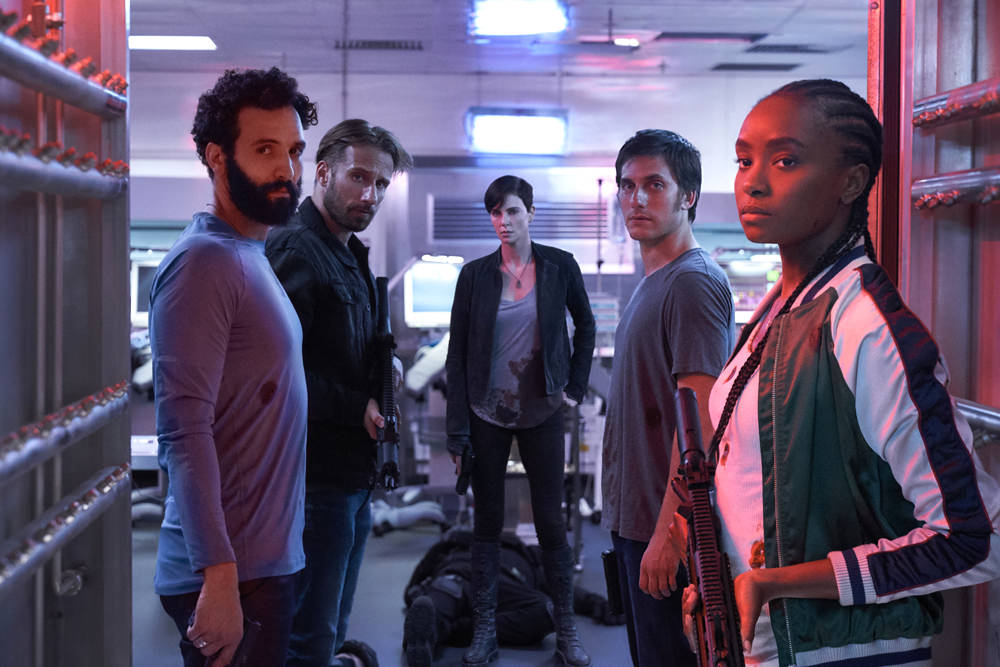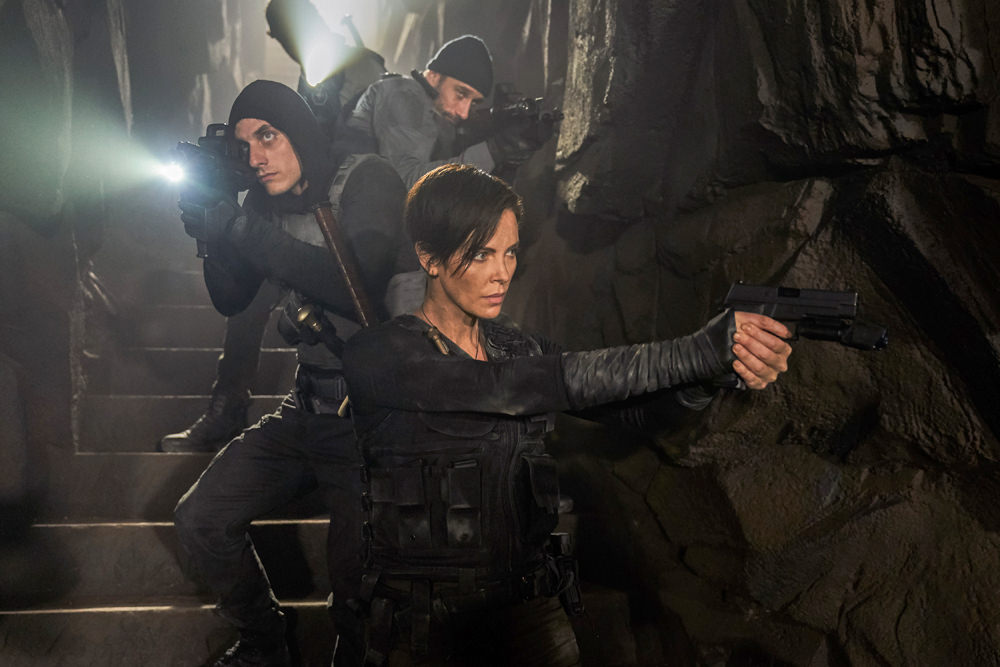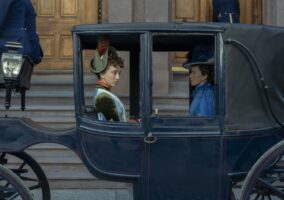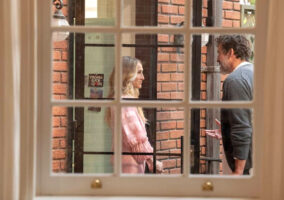
We would have loved to written a review like “The Old Guard is the mindlessly fun action film we all need right now to take our minds off the world” but we just can’t do it, we’re afraid. We can think of a lot of words to describe this film about immortal badass do-gooders; words like “textural,” “diverse,” “effortless,” “smooth,” or “stylish,” but the one word we can’t use to describe this film, directed by Gina Prince-Bythewood and starring Charlize Theron as a 6,000-year-old superhero leading a team of younger but still very old mercenaries with incredible bone structure, is “mindless.” If anything, the opposite word seems way more appropriate as a descriptor. The Old Guard is, in so many ways, a standard superheroic action film with lots of guns and an enormous body count, but despite all the punching and stabbing and shooting and eviscerating, it’s one of the most mindful action films we’ve ever seen.
Based on the graphic novels of the same name, The Old Guard starts with Andromache (Theron) reuniting with her team of immortal charges, Matthias Schoenaerts as Booker, a Frenchman from the Napoleanic wars, along with Marwal Kenzari as Joe and Luca Marinelli as Nicky, a couple who have been together since they first killed each other fighting on opposite sides of the Crusades. You can already see the possibilities of this story just with the introductions of the main characters, but what makes the opening scene so interesting is how Prince-Bythewood economically and evocatively sets up the characters, their history, and the story going forward. And she did it by simply handing Charlize Theron a piece of baklava and asking her to eat it on camera. The sensual and leisurely pace of this scene is something of a primer for the rest of the film, which manages to punctuate these quiet, hypnotic character moments with eye-popping onscreen violence. It also sets up the main question of the film, which is whether the centuries of violence the team has engaged in to serve the greater good has actually ever been worth it. “Andy” is old and seemingly tired of the fight, deeply unsure that her life’s work has ever been worth the cost.
The film then spends the next 90 minutes or so asking this question over and over again, as the body count mounts and the viewer starts to realize that the team isn’t fighting so much for the common good at the moment as to stay alive while mercenaries hired by an amoral pharmaceutical executive try over and over again to capture them. Kiki Layne is introduced as Nile, the newest member of the OG (and the audience identification character who gets to ask all the questions we’re thinking) and as soon as she gets over her confusion, she immediately questions whether a life of constant violence is any kind of life at all. Rarely in action films do you see this much time and effort devoted to questioning their actions and approach. We won’t give away how this question is resolved at the end of the film, but we’ll note two things Prince-Bythewood did during the story to support this theme. The first is how often the bad guys’ weapons are used against them in fight scenes. Not only does the hand-to-hand combat style favored by Andy tend to wield a person’s own limbs and weapons against them, but through the many gun battles in the film, OG team members are constantly shown picking up the discarded guns of their fallen enemies and using them to continue the fight. It’s a neat, subtle, and silent visual affirmation that the OG is only in this fight because the other side insists on it.

In the middle of the film, Charlize Theron’s character gets bandaged and her wounds tended to by a young woman in a Parisian pharmacy. Prince-Bythewood lingers on this scene as much as she did the one with the baklava and if you were an impatient sort of viewer, you might think both scenes were unnecessary. But just as the baklava scene illuminated Andy’s long life, the scene in the pharmacy underline the film’s main theme: you do good in the hopes that the person you help will pay it forward and make the world better. This is a subtle, humanistic, and uncommonly kind-hearted view for a film punctuated with so many gun battles and dead bodies, but it works – especially at the end, when this theme more or less wraps up the current film and beautifully sets up a potential franchise.
Gina Prince-Bythewood is the first Black woman to direct a major superhero action film and while we’d hate to turn every choice she made into a discussion on her identity, we’d be remiss if we didn’t point out how the film’s humanism as well as its effortless diversity gives the entire production a freshness and newness the genre desperately needs post-Avengers: Endgame. Only one of the leads is played by an American and none of the film takes place anywhere near the United States – another enormous departure from your typical comic book franchise film. There’s off-the-charts chemistry among all of the team members. Theron is the kind of A-list actor gifted with the ability to find chemistry with practically anyone else onscreen, making her the perfect choice to play the team leader. Her deeply personal, but wholly unromantic exchanges with Matthias Schoenaerts are some of the best scenes in the film, but it’s her insane rapport with Kiki Layne that drives the whole story. And we would watch an entire series about Nicky and Joe, the centuries-old lovers whose status as a same-sex couple is neither underlined nor ignored. It simply is – and that may be the most refreshing, most revolutionary part of this film. Superhero movies tend to give at least one character a chance to give a speech about what drives them and how they take strength from the love in their life. Prince-Bythewood and the film’s writer Greg Rucka (who also wrote the comics) seem to understand how trite and cliched these scenes can be because they gave that task to Joe, who spoke to his captors eloquently of his intense, centuries-long feelings for the love of his life before passionately kissing him in one of the film’s best, most refreshing scenes. You just don’t get that level of effortless, agenda-free queerness in a film unless it’s being directed by someone who considers diversity to be a fair and accurate representation of the world rather than an artistic statement or an attempt to pander to a segment of the audience.
When people call a film stylish, they tend to mean that the characters are dressed fashionably and the art direction is chic, but in this case, we keep returning to the word because The Old Guard tells a story that could have been no more than a succession of tired cliches in such a fresh, modern, and open way that it feels like a revitalization of an entire genre. Its style isn’t so much about its chicness or even its visuals so much as it is about the overall approach, which takes a tired genre and turns it into something that excites with its feeling of newness. If this is what’s next for superheroes, we’re all for it. And we can’t wait for the sequel.
[Photo Credit: Netflix]
Giambattista Valli Fall 2020 Couture Collection Next Post:
WERQ From Home: Kiki Layne Puts in the Effort on “The Old Guard” Virtual Press Tour
Please review our Community Guidelines before posting a comment. Thank you!



